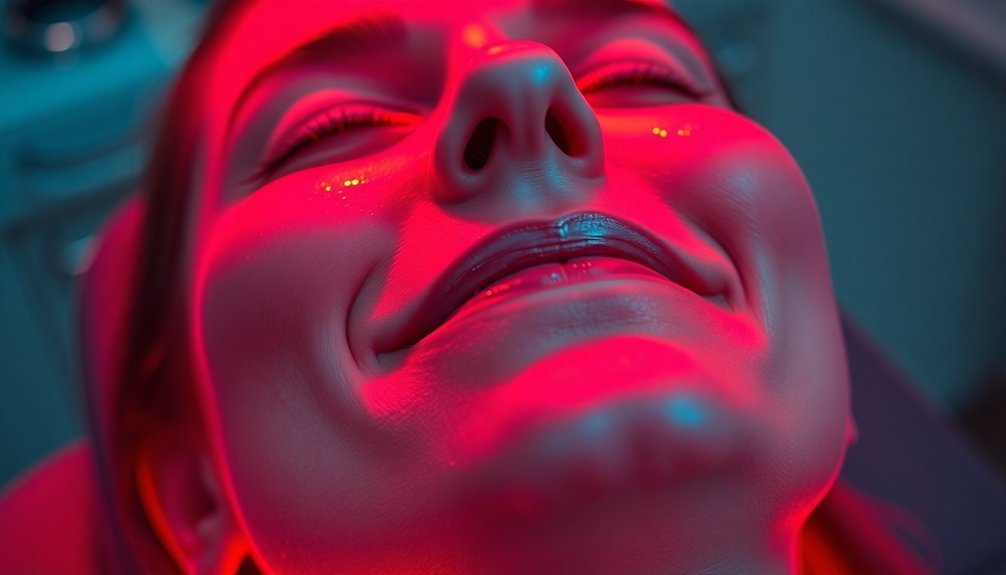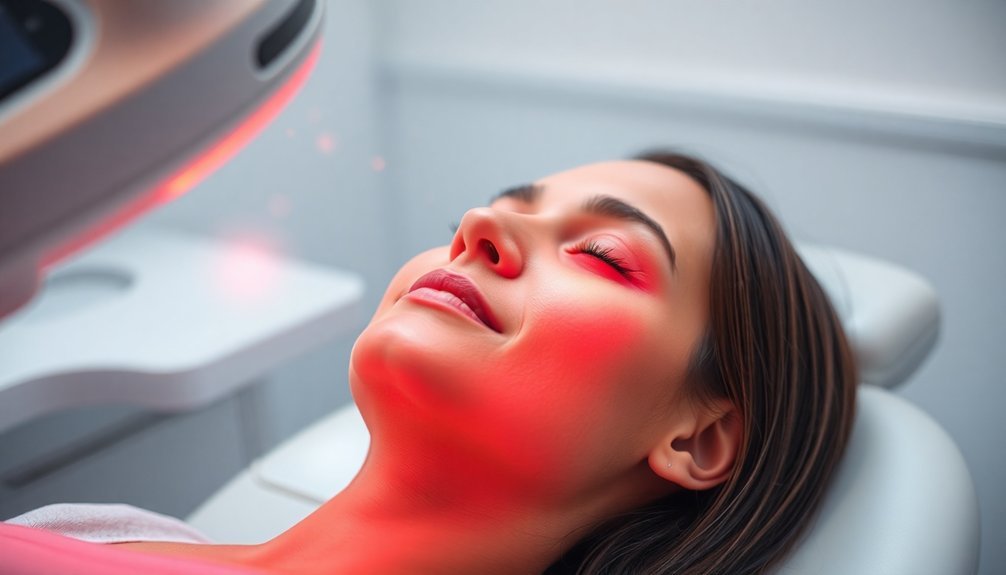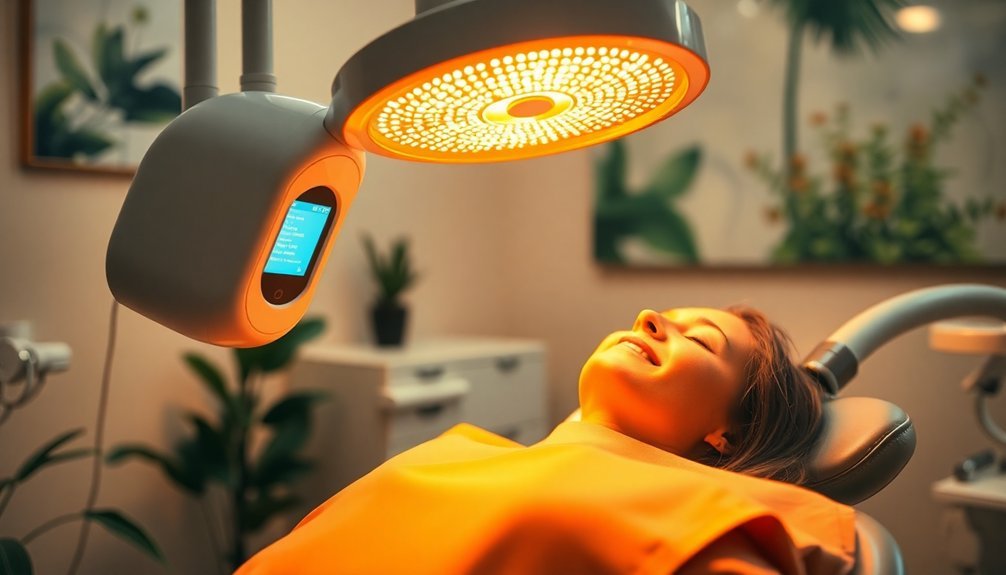Infrared treatment reduces painful dental swelling by boosting blood circulation, which delivers essential nutrients and oxygen to your oral tissues. This process not only accelerates healing but also reduces inflammation and discomfort from conditions like gingivitis. Additionally, infrared therapy helps relax jaw muscles, alleviating TMJ-related pain, and stimulates endorphin production for pain relief. It promotes collagen production, aiding tissue repair and enhancing recovery after dental procedures. Overall, it's a non-invasive way to manage oral health that can lead to better outcomes. There's much more to discover about its benefits for your dental wellness.
Enhanced Blood Circulation

When dealing with dental swelling, enhanced blood circulation plays an essential role in your recovery. It boosts nutrient and oxygen delivery to your oral tissues, which is critical for healing.
With infrared therapy, the increased blood flow helps maintain healthy gums and teeth, allowing your body to repair tissue more efficiently. The nutrients and oxygen in your bloodstream are fundamental for tissue regeneration, which supports your overall oral health and keeps your gums resilient against infections.
Increased circulation also promotes cellular function, stimulating your cells to work more efficiently and produce more energy. This means your body can tackle potential issues like gum disease more effectively. Additionally, improving circulation can expedite healing post-dental procedures, reducing discomfort and supporting recovery.
Improved blood flow helps reduce post-procedure swelling and discomfort. It aids in flushing out toxins and waste products, accelerating your recovery time and minimizing pain.
Anti-inflammatory Effects
As enhanced blood circulation promotes healing, it also plays an essential role in reducing inflammation. Infrared therapy effectively mitigates the swelling and discomfort associated with dental issues like gingivitis and periodontitis. By improving circulation and supporting cellular repair, this treatment considerably modulates the inflammatory response, which is crucial for managing chronic inflammatory conditions. Research shows notable reductions in inflammation in patients with periodontal disease who receive infrared therapy. Furthermore, it is well-known that infrared light penetrates deep into tissues, enhancing blood flow and delivering vital nutrients to support recovery.
Moreover, infrared treatment targets specific dental conditions, providing benefits for TMJ disorders and post-operative recovery. Here's a quick look at how infrared therapy addresses inflammation:
| Benefit | Mechanism | Impact |
|---|---|---|
| Reduces Inflammatory Response | Improves circulation | Eases discomfort |
| Enhances Cellular Repair | Stimulates metabolic activity | Promotes tissue regeneration |
| Supports Gum Health | Detoxification and blood flow | Prevents gum recession |
| Manages Gum Diseases | Controls inflammation | Reduces pain |
| Alleviates Postoperative Pain | Aids in recovery | Speeds up healing |
Pain Relief Mechanisms

Numerous pain relief mechanisms are activated through infrared therapy, making it an effective option for managing dental discomfort. This therapy goes beyond just providing heat; it enhances blood circulation and promotes various biological processes that contribute to pain relief.
- Boosts blood circulation: Infrared therapy delivers essential nutrients and oxygen to oral tissues, helping maintain oral health.
- Relaxes jaw muscles: The heat helps alleviate pain associated with TMJ disorders, improving your overall quality of life.
- Stimulates natural painkillers: It increases the production of endorphins, your body's natural pain relief agents, reducing discomfort from dental conditions.
- Improves nerve conduction: Enhanced sensory nerve conduction velocity influences the pain gate mechanism, effectively managing pain.
- Promotes detoxification: Enhanced circulation aids in removing toxins from the area, which is vital for healthy gums and quicker recovery. Additionally, the therapy's anti-inflammatory effects help reduce swelling in the jaw and mouth, promoting a quicker return to normal function.
These combined effects not only minimize swelling but also speed up recovery, leaving you with greater comfort and improved oral health after dental procedures.
Cellular and Tissue Repair
When you use infrared treatment, you're not just easing pain; you're enhancing cellular regeneration.
This process stimulates collagen production, which is essential for repairing damaged tissues in your mouth.
Enhanced Cellular Regeneration
Healing plays a crucial role in enhanced cellular regeneration, especially in the context of dental care.
You'll find that improved blood circulation is key, as it delivers essential nutrients and oxygen to your oral tissues. This increased blood flow helps relax arteries while preventing platelet clumping, maximizing your body's healing mechanisms.
Here are some important benefits of enhanced cellular regeneration through infrared treatment:
- It decreases inflammation, promoting the removal of waste products from affected areas.
- Enhanced cellular energy production accelerates the repair process, especially after dental procedures.
- The treatment boosts the activity of fibroblasts, vital for tissue remodeling and repair.
- It promotes optimal circulation, ensuring your tissues remain resilient against infections.
- You'll experience a reduction in healing time, helping you recover faster from oral injuries or surgeries.
Collagen Production Stimulation
Collagen production stimulation is essential for effective cellular and tissue repair, especially in dental health. When you undergo infrared therapy, the infrared light penetrates deep into your tissues, activating metabolic events that support healing. One of these events involves the production of nitric oxide, which relaxes your arteries and enhances blood flow. This increased circulation brings critical nutrients and oxygen to injured areas, resulting in improved collagen synthesis.
As fibroblast activity increases, you'll notice a boost in collagen production, which is important for forming new, resilient tissue. Infrared therapy, particularly using near-infrared light in the 800-900 nm range, accelerates the wound healing phase by encouraging tissue repair and regeneration. This therapy also helps reorganize new tissue, making it strong and less susceptible to re-injury.
For your oral health, stimulating collagen production supports gum tissue regeneration and reduces issues like gum recession. If you've undergone dental procedures, such as bleaching, infrared therapy aids in healthy tissue recovery by promoting collagen fiber maturation.
Stress Reduction Benefits

Among the various treatments available, infrared therapy stands out for its ability to greatly reduce stress levels, which can have a profound effect on your oral health.
When you lower your stress, you're taking an important step toward preventing issues like bruxism and TMJ disorders. Chronic stress can lead to oral health problems that can be difficult to manage, but infrared therapy offers an effective way to address stress directly.
Here are some key benefits of infrared therapy for stress reduction:
- Promotes relaxation by using deep heat that soothes both body and mind.
- Stimulates endorphin production, enhancing your mood and reducing anxiety.
- Reduces inflammation and discomfort in jaw muscles, aiding in TMJ relief.
- Helps you maintain better oral hygiene habits by promoting a more relaxed state.
- Supports overall mental health, reinforcing your commitment to oral care.
Specific Dental Health Advantages
Infrared treatment greatly boosts blood circulation in your gums, delivering crucial nutrients and oxygen essential for oral health.
This enhanced blood flow not only nourishes your tissues but also fosters healing and regeneration.
Additionally, its anti-inflammatory effects help reduce swelling and discomfort, making your gums healthier and more resilient against diseases.
Enhanced Blood Circulation
When it comes to dental health, enhanced blood circulation plays an essential role in supporting your oral tissues. By improving blood flow, you're actively aiding your gums and teeth in maintaining their health.
The benefits of increased circulation are significant, as they guarantee that vital nutrients and oxygen reach your oral tissues effectively. Here's how enhanced blood circulation benefits you:
- Boosts nutrient delivery to gums and teeth
- Speeds up healing after dental procedures
- Improves gum health by reducing the risk of disease
- Reduces dental pain through muscle relaxation
- Promotes overall oral health and well-being
With better circulation, your body can accelerate recovery time, allowing tissues to regenerate more effectively.
It also keeps your gums resilient and less susceptible to infections. This proactive approach helps not just after procedures, but also in daily oral health maintenance.
By focusing on enhancing circulation, you can enjoy a healthier mouth, reduced discomfort, and a lower risk of dental issues in the long run.
Embracing infrared treatment could be a key step towards safeguarding your dental wellness.
Anti-inflammatory Effects
Inflammation is a common challenge in dental health, but using infrared treatment can greatly ease this issue. This therapy reduces your inflammatory response, helping to mitigate swelling and pain associated with conditions like gingivitis and periodontitis. Studies published in the "Journal of Clinical Periodontology" support its effectiveness in managing periodontal issues, potentially decreasing the need for more invasive interventions.
Infrared treatment also promotes tissue regeneration by enhancing cellular repair mechanisms and stimulating collagen production. This leads to faster healing after dental procedures like extractions and implants.
Here's a visual representation of the key benefits:
| Benefit | Description | Effect |
|---|---|---|
| Reduction in Inflammation | Mitigates swelling and pain | Eases discomfort |
| Tissue Regeneration | Enhances healing through collagen stimulation | Supports recovery |
| TMJ Management | Alleviates jaw pain and reduces inflammation | Improves jaw movement |
Long-term Oral Health Impact

Long-term oral health benefits from infrared and red light therapies are considerable and multifaceted, enhancing your overall dental well-being.
These therapies not only address immediate issues, but they also contribute to lasting improvements in your oral health.
- Enhanced Blood Circulation: Better blood flow delivers essential nutrients and oxygen to your oral tissues, promoting faster healing and minimizing gum disease risks.
- Reduced Inflammation: By tackling inflammation, these therapies help manage conditions like gingivitis and periodontitis effectively.
- Gum Disease Prevention: Using these therapies regularly can considerably reduce the chances of developing gum diseases.
- Pain Management: They provide relief from pain, especially valuable post-procedure, making recovery smoother.
- Non-Invasive Treatment: Both therapies offer safe, non-invasive solutions to manage and improve oral health.
Frequently Asked Questions
How Long Does It Take to See Results From Infrared Therapy?
You can see initial results from infrared therapy within just one session, with markedly reduced pain in about 1-4 weeks of consistent treatment. Starting with short sessions typically leads to the best outcomes over time.
Can Anyone Use Infrared Therapy for Dental Issues?
Yes, most people can use infrared therapy for dental issues, but it's best to consult a healthcare professional first. This therapy can complement your treatment, especially for post-operative care or chronic dental conditions.
Are There Any Side Effects of Infrared Treatment?
Yes, there are side effects of infrared treatment. You might experience skin sensitivity, increased discomfort, or complications if you have certain medical conditions. Always consult a healthcare professional beforehand to guarantee it's safe for you.
How Often Should I Undergo Infrared Therapy Sessions?
You should undergo infrared therapy sessions regularly, ideally once daily for about 10 minutes. For maintaining oral health, a few sessions each week could be enough, adjusting based on your specific needs and concerns.
Can Infrared Therapy Be Combined With Other Dental Treatments?
Yes, you can definitely combine infrared therapy with other dental treatments. It's great for enhancing recovery after procedures, minimizing pain, and swelling, making your post-treatment experience much more comfortable and effective overall.
In Summary
To sum up, infrared treatment is an effective way to reduce painful dental swelling by enhancing blood circulation, providing anti-inflammatory effects, and promoting pain relief. It helps repair cells and tissues while also reducing stress, offering specific benefits for your dental health. By incorporating infrared therapy into your oral care routine, you can enjoy both immediate relief and long-term improvements in your overall oral health. Give it a try to experience the positive impact it can have!





Leave a Reply